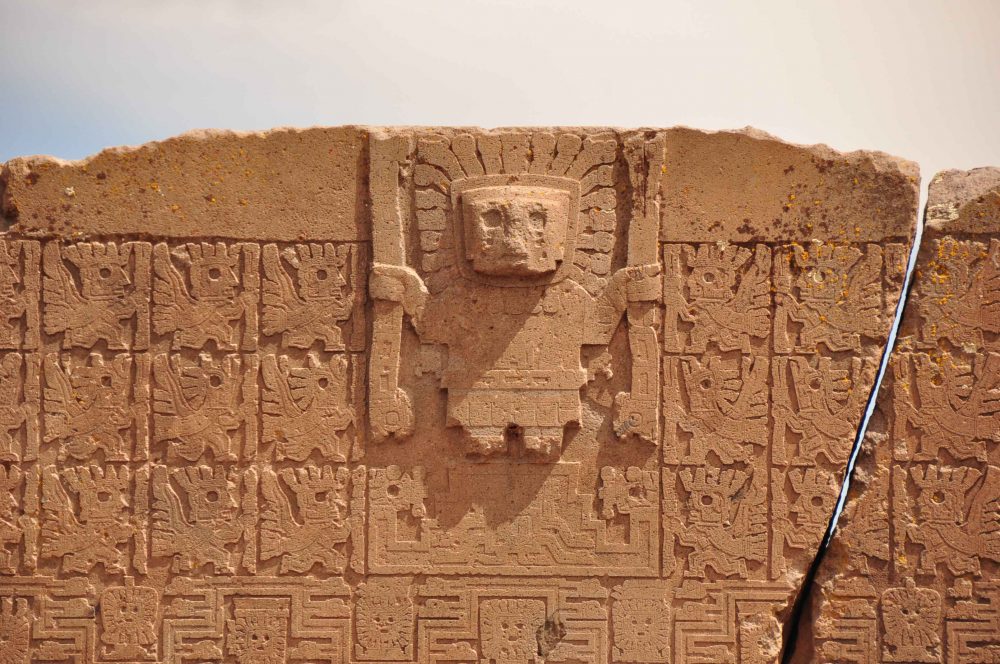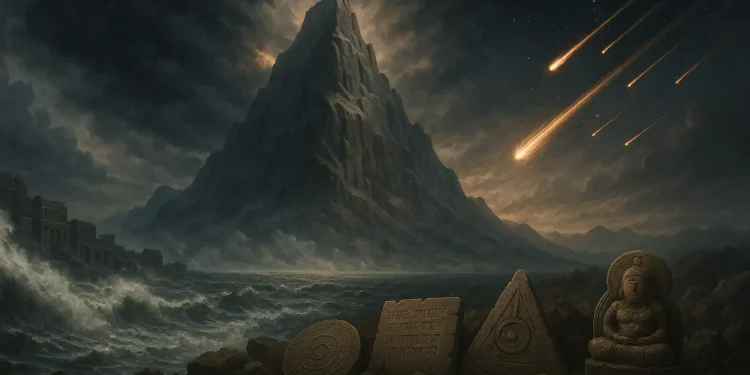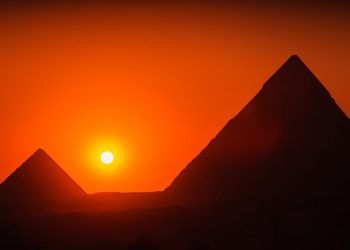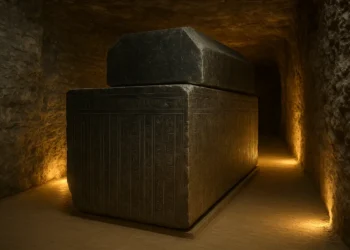Before history was written down, it was remembered. Ancient myths were more than stories, they were cultural memory. Told by firelight, preserved in chants, carved into walls, and passed down by generations who had no books, no archives, and no way to record the past beyond their words.
Across time and across the world, many of these stories contain the same themes. Floods that erase civilizations. Gods who arrive from the sky. Sacred mountains where heaven touches Earth. A golden age that ends in loss. These themes are not limited to one place or one people. They repeat in Mesopotamia, in Mesoamerica, in the Vedic texts of India, in the oral traditions of Aboriginal Australia, and in the myths of ancient Greece and Egypt.
The question is, why? Why do so many ancient myths, told by cultures that never met, sound like variations of the same story? And if the similarities are more than coincidence, what are they trying to tell us?
Myths of the flood and the memory of a lost world
Among the most common ancient myths is the story of a world-ending flood. It is told with striking emotional weight across multiple civilizations. In Mesopotamia, the Epic of Gilgamesh describes how Utnapishtim survives a divine flood sent to wipe out humanity. In the Book of Genesis, Noah receives a warning to build an ark. In India, the figure of Manu escapes destruction after being guided by a talking fish. Greek myths recall Deucalion and Pyrrha, the only survivors of a deluge sent by the gods.
The same theme appears in Aztec and Inca tradition, as well as in the Pacific Islands and Indigenous Australian stories. These are not watered-down copies of the same tale. They are culturally unique but carry the same structure: a flood, a warning, a survivor, and a world reset.
Many researchers now believe that such stories may contain real memories. After the last Ice Age, around 12,000 years ago, the planet went through a dramatic climate shift. Melting glaciers caused sea levels to rise by more than one hundred meters. Entire coastlines disappeared. Settlements were flooded and landscapes transformed.
Some scientists point to the Black Sea flood theory, which suggests that around 5600 BCE, the Mediterranean breached into the Black Sea basin, causing a sudden and devastating rise in water levels. If true, such an event could have left a powerful impression, passed on through oral tradition for thousands of years.
These flood myths may not be symbolic at all. They may be the only surviving record of a prehistoric global disaster.
Sky gods, fire from above, and celestial memory

Another powerful pattern in ancient myths is the sky god, a divine figure who controls thunder, lightning, sunlight, or fire. In Greece, Zeus ruled the skies and hurled bolts of lightning. In Norse myth, Thor struck enemies with his hammer. In India, Indra was the lord of storms. In the Andes, Viracocha came from the heavens. The Aztecs worshipped Tlaloc, who brought both rain and destruction.
This consistency raises the question: why were so many early gods associated with the sky, with storms, or with fire from above?
One possibility is that ancient people witnessed real events in the sky they could not explain. Comets, solar flares, meteor impacts, and auroras would have appeared mysterious and terrifying. They may have inspired myths of gods who descended with power and wrath.
The Younger Dryas Impact Hypothesis, for example, suggests that around 12,800 years ago, a comet or fragments of one struck the Earth, sparking fires and climate disruption. While still debated, this theory has gained attention in recent years. If true, the fear of the sky may not have been metaphorical. It may have been remembered.
In that context, the fire-bringing gods and celestial battles could reflect a prehistoric trauma, retold through myth, or reimagined through divine figures.
Sacred mountains as portals to the divine
Across mythologies, mountains are more than geographical features. They are places of revelation, refuge, or power. Mount Meru in Hindu and Buddhist tradition is said to be the center of the universe. Mount Olympus in Greek myth is home to the gods. In the Bible, Mount Sinai is where Moses receives divine law. In ancient Persia, Mount Alborz holds cosmological significance.
High places appear again and again as bridges between heaven and Earth. In Sumer, the earliest ziggurats were built to mimic sacred mountains. In Mesoamerica, pyramids aligned with celestial events served similar spiritual functions.
Why this fascination with heights? In some cases, mountains may have served as real-world refuges from floods or chaos. Their permanence and elevation made them powerful symbols of protection. In others, they may have simply represented a place closer to the heavens, where divine encounters felt possible.
The connection between elevation and revelation is more than poetic. It reflects how early societies tried to locate the divine in the physical world, often by reaching upward.
Creation from chaos and the shape of ancient thought
Another theme that appears in ancient myths is the idea of creation emerging from chaos. In Egypt, the primordial waters of Nun precede all existence. In Mesopotamia, the goddess Tiamat gives birth to the first gods before being slain by Marduk. In China, Pangu breaks free from a cosmic egg and separates heaven from Earth. Greek myths tell of Chaos giving rise to Gaia and Uranus.
These myths are not just origin stories. They reflect an early attempt to understand structure, transformation, and time. They begin with a void, water, darkness, formlessness, and then describe how form, order, and life emerged.
What is remarkable is how widespread this framework is. The idea of a structured cosmos emerging from a primal state appears across continents and civilizations. Long before science, these myths were the first tools used to explain existence.
They also reflect the ancient belief that order is fragile. What was once whole can break. What exists now once did not. And what seems permanent can vanish.
Could these shared stories point to a forgotten connection?
The academic view has long been that myths developed in isolation, shaped by environment and psychology. But this view is now under pressure. The repeating structures found in myths across the globe are too specific and too numerous to dismiss.
Some scholars explain the patterns as universal archetypes,mental frameworks shared by all humans. Others point to similar challenges faced by early societies that led to similar storytelling.
But there is another possibility. Before written history, humans may have traveled and shared more than we think. Oral knowledge, navigation, and memory may have connected cultures long before global trade or formal writing.
If so, ancient myths may be the final trace of a forgotten chapter in human history, one that predates all records and all maps.
Across Sumer, Egypt, India, China, the Americas, and Oceania, the same motifs appear. Floods, sky gods, lost worlds, sacred mountains. These stories are not identical, but they rhyme. And in that rhyme, there may be memory.
Myths were never just stories
It is easy to treat myth as fiction, especially in a world shaped by science. But myths were never just stories. I see them as vehicles for knowledge, warnings, and cultural identity.
What ancient myths have in common and why it matters today is not about fantasy. It is about understanding how human beings remember. These stories tell us how early civilizations faced environmental shifts, unexplained events, and loss. They show how people coped with fear, disaster, and awe.
As the modern world faces rising seas, extreme weather, and social upheaval, the old stories feel newly relevant. Not as prophecies, but as reflections of what humans have endured before. They remind us that beneath the facts and data, we are still meaning-makers.
The myths of the past may not be literal. But they hold something real. They carried truths across time without paper, without language as we know it. And in that survival, they still speak. If we are willing to listen, they may tell us what we have forgotten, and what we still need to remember.











